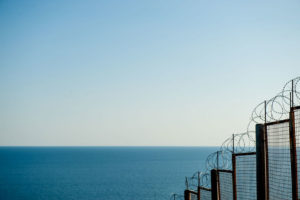Do Not Build The Wall
March 4, 2019
The border between the United States and Mexico stretches for nearly 2,000 miles from the Gulf of Mexico to the Pacific Ocean and touches the states of California, Arizona, New Mexico and Texas.
During his 2016 presidential campaign, President Trump stated that he was going to build a border wall and have Mexico pay for it. But Mexico said that they were not going to provide any money for a wall, leaving Trump to argue with Congress about funding, which prompted the 35-day partial federal government shutdown, and now his declaring a national emergency.
One of Trump’s arguments for a border wall is that illegal immigrants bring drugs into the U.S. He is somewhat right as an estimated 94 percent of heroin in the U.S. is brought in from Mexico, according to the U.S. State Department. But according to Customs and Border Protections, 81 percent of hard drugs, such as methamphetamine, heroin, fentanyl, etc., come through legal ports of entry and are not smuggled over the border. Smugglers use many methods of getting drugs into the country, including drones, planes, cars, tunnels, ships, submarines, ladders, and catapults. They hide drugs inside shipments of fresh produce and fish, inside cans disguised as food, and inside fake food.
Another of Trump’s arguments is that immigrants bring crime into the U.S. But in California, which is home to many legal and illegal immigrants, American-born men are incarcerated at 2.5 times the rate of foreign-born men, according to CNN. The reason many immigrants don’t commit crimes and end up to prison is that they don’t want to be deported. Staying out of trouble also means a better possibility of becoming a legal citizen.
The argument that terrorism made its way through the U.S.-Mexico wall is not true. From a practical standpoint, it is easier to get through other borders than the U.S.-Mexico border because of how well guarded it is. There is no recorded data of a terrorist coming over the border. Also, terrorists aren’t undocumented. In fact, most terrorists active in the United States are homegrown. Of the 2,554 people on the Terror Watch List who tried to enter the U.S. in 2017, 2,170 of them tried to enter at airports, according to The Washington Post.
From a financial standpoint, Trump wants $5.7 billion — about $15 per American — to fund this wall according to CNN. If Congress passes a bill to fund the wall, then the wall would be funded by the American taxpayer. But ultimately, the wall is expected to cost $12 billion out of the government. On top of the cost to build the wall, the U.S. economy would lose more than $4 billion a year because we would have to keep on funding for the wall, meaning the country would forfeit nearly $30,000 in lost economic output for each Mexican migrant the wall stops. There is no real estimate on how many immigrants the wall would stop because according to many sources, many immigrants come through legal ports of entry.
Research shows that he main reason the border wall would be bad is because it would hurt the U.S. economy since there would be fewer workers and lower output. It would have only a tiny impact on illegal immigration, and U.S. workers wouldn’t be better off. “Our research shows that building a wall was an ineffective way of reducing migration,” said economists Treb Allen of Dartmouth College after presenting a new research paper at the American Economic Association Conference in January. “It was expensive to build, and it harmed U.S. workers.”
Also, most Americans do not want the wall, according to many polling sources. Even many Trump supporters don’t agree with the building of the wall. During his presidential campaign, Trump made it seem like the wall would be built easily with funding from Mexico. But now, he and his supporters realize that it is not as easy as it seemed.
The wall will also affect the environment. According to National Geographic, The border fencing will affect seasonal migration for animals by blocking water sources and birthing sites for animals that roam to California and Mexico. The wall will also disrupt wildlife refuges and parks. Or example, in Mission, Texas, the National Butterfly Center, where more than 200 butterfly species live near the banks of the Rio Grande, has been notified that the wall will divide the 100-acre sanctuary, placing almost 70 percent of it on the Mexican side of the wall.


